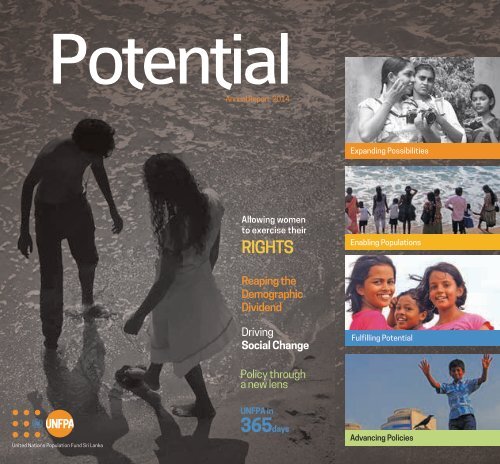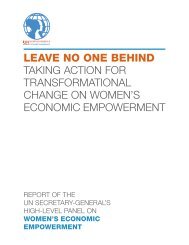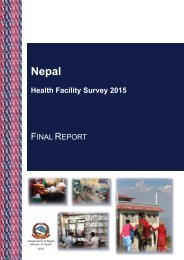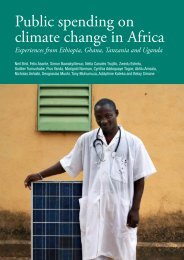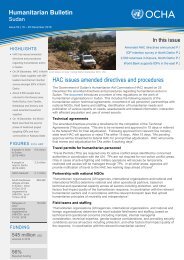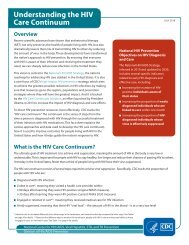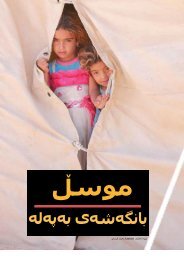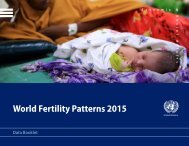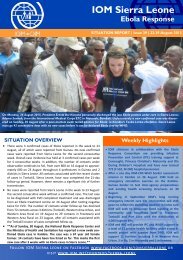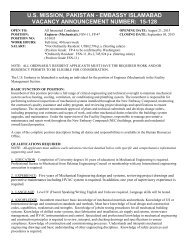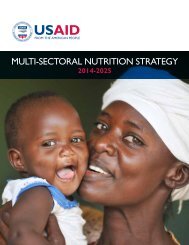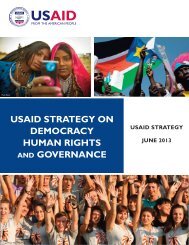1Tw2l0y
1Tw2l0y
1Tw2l0y
You also want an ePaper? Increase the reach of your titles
YUMPU automatically turns print PDFs into web optimized ePapers that Google loves.
PotentialAnnual Report 2014Expanding PossibilitiesAllowing womento exercise theirRIGHTSEnabling PopulationsReaping theDemographicDividendDrivingSocial ChangeFulfilling PotentialPolicy througha new lensUnited Nations Population Fund Sri LankaUNFPA in365daysAdvancing Policies
ContentsPage 820 Voices in 2014 | 02Expanding PossibilitiesAllowing women to exercise their rightsSexual Violence... It’s time to talk about itInterview with Dr. Anuruddhi EdirisingheConsultant Forensic PathologistUNFPA in Action | 06 - 07Sexual Violence... It’s time to talk about itInterview with Dr. Anuruddhi Edirisinghe,Consultant Forensic Pathologist | 08UNFPA in Action | 10 - 11Capturing Impact | 12Enabling PopulationsReaping the Demographic DividendPages 24-25Empowering Youth :MaximizingDividendsInterview withDr. Harsha De SilvaDeputy Minister PolicyPlanning & EconomicDevelopment.Otara GunewardeneFounder of ODEL & EmbarkUNFPA in Action | 18-19Get the Facts | 20Empowering Youth : Maximizing Dividends | 22Fulfilling PotentialDriving social changeA new model of youth leadership | 30Hear what some of the Social ChangeEntrepreneurs have to say about their experienceso far: | 31UNFPA in Action | 33A new model of youth leadership...Page 30Advancing PoliciesPolicy through a new lensUNFPA in Action | 36-38UNFPA in 365 days | 40Our Results | 42Policies… Thinking out of the boxPages 38-39
United NationsPopulation FundSri LankaWho are we ?We are a diverse, dynamic and talentedwork-force accompanying Sri Lanka in itssocio-economic development as its referencepartner of choice.Our overall commitment is to advance equity,accountability and quality in all spheres ofdecision-making, affecting the lives andpotential of the Sri Lankan population, withwomen and youth as our main actors andbeneficiaries of our interventions.
20 Voices in 2014Confident to get all of my colleagues to their fullest potential and on-boardfor a rewarding journey of personal and organizational transformation.Alain Sibenaler - UNFPA RepresentativeUNFPA guidelines does not permit extensions beyond the age of retirement. Unless it isabsolutely difficult to find a suitable candidate. However, an extension was workedout for the programme Secretary beyond the age of retirement.Tilaka Dissanayake - Personal Assistant to RepresentativeWe have been striving to be effective and innovate in communicating about the issues thatare at the heart of our work, from meeting the sexual reproductive health needs and rights ofwomen and young people, reaping the benefits of a demographic bonus and in bringing a newpolicy lens towards population issues. In 2015 we hope to be more-cutting edge in how wecommunicate and address these issues . Lankani Sikurajapathy - Communication AnalystWe were able to launch the National Needs Assessment on Emergency Obstetric andNeonatal Care and support the finalization of national medico-legal guidelines on sexual abuse.I am looking forward to integrate further UNFPA’s vision on women and adolescent health inthe Ministry of Health in the coming year. Jayan Abeywickrama - Programme Analyst – EMONCIn 2014 we completed capacity building training of frontline officers of the Ministry ofWomen’s Affairs dealing with grass roots level issues of gender-based violence and violenceagainst women. In 2015, I look forward to develop policy monitoring mechanisms of theMinistry of Women’s Affairs through data processing and reporting.Nirosha Welgama - Programme Analyst – GenderIn 2014 I was promoted to the position of senior driver. Therefore, Ilook forward to continue my work effectively and efficiently in theupcoming year.David Raju - Senior DriverYear 2014, was both challenging and rewarding for the operations team, achievingexcellence in HR, Finance, ICT and General Administration functions at the country office.I am a strong supporter of UNFPA’s “Going-Green” initiative and dedicate to developinnovative ideas which can be done individually and collectively.Priyan Perera- Operations ManagerWhen I joined in December 2014, I was planning on doing just one great project. However,I have been inspired to work on AbleApp, Idiriya, Adahas and sustainable business projects,thus my work is focusing on creating positive impacts in Sri Lanka by empoweringcommunities, providing ease of access to vital information and creating better advocacy.Anoka Abeyrathne - Social Change Entrepreneur2014 saw me working to coordinate a series of successful projects for the 16 Days ofActivism Against Gender-based Violence by the National Forum Against GBV. In 2015 I willwork with the Arts and New Media to launch novel channels, namely the inter-generationalArt for Advocacy collective by creating strategic partnerships with the private sector.Munira Mutaher - Social Change Entrepreneur| 2I was able to effectively manage the structural changes of the country officethat took place during 2014. I look forward to contribute my fullest towardsthe procurement and administrative work in 2015.Chandramogan Nadesan - Finance and Admin Associate
UNFPA Annual Report 2014UNFPA Sri Lanka started its transition in 2014 from service delivery to policy advocacy.This was an immense transition which we were able to successfully convince ourstakeholders towards a smooth conversion enabling effective adaptation to themodality of policy advocacy. Therefore, I am indeed looking forward to successfullycomplete this transition in 2015. Gamini Wanasekara - Assistant RepresentativeI have been developing a population portal as well as creating a model on socialenterprise to achieve sustainable livelihood of women in the eastern province of SriLanka. I hope to achieve successful completion of these projects in 2015.Manahari Panditharatne - Social Change EntrepreneurWe were successful in establishing a secretariat to implement the national youth policy inthe Ministry of Youth. We also were a main sponsor of the World Youth Conference held inSri Lanka 2014. I am now looking forward to take the concept of youth forums to the subnationallevel and involve these youth in policy making processes.Nishantha Warnasooriya - Programme AnalystI had a successful year at UNFPA in 2014 and I look forwardto deliver my fullest in 2015K.P. Gamini - DriverI designed UNFPA’s 100 Voices – Leading for Change campaign to educate youth about sexualreproductive health and rights and gender-based violence. I look forward to complete my journey asa social change entrepreneur, continuing the 100 Voices campaign, and delivering my final project“Women in Plantations” a research compilation on violence against women in Sri Lankantea plantations. Onalie De Silva Ariyabandhu - Social Change EntrepreneurIn 2014, I initiated an advocacy process to bring policy level change to eradicate sexualharassment in public places; a nationwide research on this will be conducted in 2015. I amalso working on gender inequality in Disaster Risk Reduction practices and processors of SriLanka as well as to engage youth at the provincial level in decision making processes.Naushalya Rajapakse - Social Change EntrepreneurIn 2014, I received a special appreciation note from UNFPA Myanmar CountryOffice for my human resource support. I look forward to further learning anddevelopment in 2015.Geetha Fernando - Programme and Admin AssociateIn 2014 I was able to successfully adapt to the structural changes in the office.I am happy to say I passed the UNFPA procurement level 1 exam and I hope tocomplete the procurement level 2 exam in 2015.Rohan Dias - Finance and Admin AssistantI have been working with Ministry of Health to explore ways of improving access tofree healthcare for women in Sri Lanka through awareness and quality services.I expect to see the launch of best practices in 2015.Achini Wijesinghe - Social Change EntrepreneurI am happy to have contributed to the joint publication by UNFPA and the Dept. of Census andStatistics on the key findings of the 2012 Population and Housing Census. I am currently workinghard towards producing a publication providing a comprehensive analysis and policy focus on theentire population of Sri Lanka H. R. Gunasekera - Consultant3 |
Expanding PossibilitiesAllowing women toexercise their rights
UNFPA Annual Report 2014Expanding PossibilitiesAllowing women to exercisetheir rightsUNFPAin ActionEnhancing the supportexamination, reporting andmanagement of sexually abusedsurvivorsIn the past, procedures for addressingsexual abuse often neglected survivors’health. Now, while punishment ofoffenders will continue to be pursued,priority will be given to ensuring survivors’health, dignity and psychological wellbeing.The new guidelines set standardsfor examining survivors in a uniformmanner, providing quality forensic andhealth services, and improving healthcare workers’ knowledge and skills ofthrough teaching and training.UNFPA played a leading role in developingSri Lanka’s first medico-legal guidelinesfor examining and caring for survivors ofsexual abuse and reporting the abuse tolaw enforcement authorities, along withthe Ministry of Health, Ministry of Justiceand College of Forensic Pathology.The human rights-based guidelines wereadapted from the Guidelines on ClinicalManagement of Rape Survivors developedby WHO in partnership with UNFPA. Theywere published after years of preparationincluding numerous consultations withmedical and judicial experts.Want to learn more about theseguidelines. Check them out here:http://countryoffice.unfpa.org/srilanka/?publications=9882Bringingbehaviouralchangecommunicationin ReproductiveHealthWhile Sri Lanka has much to boostin its reproductive health outcomes,with a maternal death rate of 37.6 per100,000 live births being the lowestin South-East Asia, many reproductivehealth challenges continue to remain. Forinstance, reproductive health informationand services available for young peopleneed communication strategies thatgo beyond education and would allowfor behaviour changes in clients andservice providers resulting in improvedreproductive health outcomes.This is where UNFPA has stepped in.Partnering with the Health EducationBureau and Family Health Bureau ofthe Ministry of Health, five trilingualbehavioural change communicationstrategies covering maternal andnewborn health, family planning, genderbasedviolence, adolescent and youngpeople’s sexual reproductive health andwell woman clinics are being developed.When implemented and integrated inhealth programmes these strategies willgo a long way in meeting the reproductivehealth needs and ensuring thereproductive rights, particularly of womenand young people.Watch out for the launch ofthese strategies!!| 6
Reproductivehealth care forwomen beyond49 years of ageThe number of women over 50 yearsof age was 2.6 million in 2012. This isexpected to rise to 4.4 million by 2036,an increase of 69%. At the same timewomen are living longer and outnumbermen by 51.5% (598,921). This is mainlydue to the free reproductive health carepackage provided to women during theirreproductive years. This means that SriLankan women will live 30 years beyondtheir fertile age, for which appropriatereproductive health care is required. Toensure the wellbeing of women beyond49 years, interventions should begin aswomen reach 35 years of age.A concept was introduced in 1996to provide services for patients whohave cancers in reproductive organs(reproductive organ malignancies) as apart of the reproductive health conceptpromoted by the International Conferenceon Population and Development. This hasbeen operationalised in Sri Lanka throughthe Well Women’s Clinics programme,supported by UNFPA, to detect breastand cervical cancers of women reaching35 years of age.With more women in the population,who are living longer, the followinginterventions are needed to ensure theirwellbeing:• Recognising the health needs ofwomen beyond 49 years age as anemerging public health issue• Providing a reproductive healthpackage to address the uniqueneeds of women beyond 49 years• Expanding the coverage of WellWomen’s Clinics so that everywoman beyond 35 years receiveregular screening for the detectionof reproductive organ malignanciesTo learn more aboutwomen’s health, women’srights, youth potential anddemographic dynamics inSri Lankacheck out UNFPA’scomprehensive set of factsheets here:http://countryoffice.unfpa.org/srilanka/?publications7 |
UNFPA Annual Report 2014Expanding PossibilitiesAllowing women to exercisetheir rightsSexualViolence... It’stime to talkabout itInterview withDr. Anuruddhi EdirisingheConsultant Forensic PathologistFirst ever medico-legal guidelines for the examination,reporting and management of sexually abused survivorsin Sri Lanka.Research suggests that 1 out of 4 women in Sri Lankaare sexually abused by the time they reach age 18. Withsuch high prevalence of sexual violence, the medicolegalsystem of the country holds great responsibility inbringing justice to the survivors, legally, socially as wellas medically; ensuring lifelong medical, psychological andsocial wellbeing.Find out how this guidelines will help to improve thissituation.“Research suggests that 1out of 4 women in Sri Lankaare sexually abused by thetime they reach age 18years”| 8
A sustainableexitIn response to the increasing incidentsof violence against women and girlsfollowing the tsunami, UNFPA supporteda network of support services for womenand girls through the establishment ofwomen’s centres at the village levelto provide safe spaces and supportservices for women subjected to, or atrisk from, gender-based violence.Ten years on, these women centres havetransformed to routine service deliverycentres in the community. With UNFPA’sshift in focus in Sri Lanka from servicedelivery to policy advocacy, it hasembarked on deriving a sustainable exitfrom supporting these women centres.With the innovation and strategicthinking of UNFPA’s social changeentrepreneurs the exit strategy hasfocused on building the policy advocacyrole of the women’s centres and ensuringsustainable funding mechanisms thatwould create economic empowermentby developing marketable products.Check out the financialmethodology developedto sustain these womencentres:Manage programmes under thewomen’s centers-mostly routinecosts and routing programmeManage the women’s sheltersmostlyrouting costs and specificprogramme costs-Focus on amarketable productEarn a profit to cover basicrunning costs++ProgrammesGet donor funds for a SPECIFICplanned proposal- or as aninitial investmentRegister under Companies Actsection 7 of 2007 as a profitmaking venture and a social ventureOperationsGrantMoneyNetProfit11 |
UNFPA Annual Report 2014Expanding PossibilitiesAllowing women to exercisetheir rightsCapturing ImpactEmbracing motherhood before adolescenceA 14 year old mother struggles as a victim of incest to balance raising her newborn baby and experiencing her own childhood. She playswith her hair accessories, braiding her hair in different styles, until it’s time for her to feed her baby. This teen mother fights a constantbattle to accept she is no longer just a child; she’s the mother of her own father’s child.Victims of incest are most often unable to distinguish between expressions of affection and abuse, resulting in them not takingpreventive measures. Victims themselves often refuse to believe they’ve been sexually abused until they become teen mothers.| 12
Victimized by one, isolated by allRaped at the age of 17, a teenage mother is forced into isolation after being shunned by her community and disowned by her family.She was the youngest daughter in a family of five; she thought at least her siblings would support her and take care of her after she wasvictimized by their neighbor. She was wrong. They all disowned her and chased her out from home, calling her a disgrace, a dishonor anda burden to their family.In Sri Lanka it is estimated that 6.5% of girls are pregnant or have given birth before their 19th birthday.13 |
UNFPA Annual Report 2014Expanding PossibilitiesAllowing women to exercisetheir rightsCapturing ImpactStruggle between two worldsThey dream of running back to school every single day; to sit in class and listen to their favourite lessons, to chat with their friends overlunch and to sing and dance during free time. They wish they could go back to their normal childhood where their biggest worry was theyear end exams at school. But then, they realise their uniforms are too tight around their bellies, their swollen feet too big and painful tofit in to their school shoes.Teen mothers often drop out from school during their pregnancy due to physical difficulties, difficulties in concentration and socialstigmatisation.| 14
Finding her safe haven13 year old girl struggles to overcome her memories of violence at home. She often gets flashback of her father beating her mother, herbrother bleeding with injuries and herself tied to a chair next to the stove. Her attempts to run away from her past, brings her nowhereclose to her present or future. Her desperation and isolation not only signifies her frustration but also her attempt to find her safe haven.Domestic Violence affects both mother and child both physically and psychologically.15 |
Enabling PopulationsReaping theDemographic Dividend
UNFPA Annual Report 2014Enabling PopulationsReaping the DemographicDividendUNFPAin ActionHelping to placeCensus findingsin developmentplanningAs the population data agency, UNFPAhas been a key partner in the entirecensus process from data collection todata dissemination and most recentlyin collaborating with the Department ofCensus to launch the key findings of the2012 Population and Housing Census.This publication is unique as it not onlyillustrates data but what the data actuallymeans. With this analysis of data, policymakersand planners are better ableto include population dynamics intoinvestment strategies and developmentplans of the country.The Power of 1.8Billion: Gettingthem to thetableWe say young people should be part ofthe decision-making process on issuesthat affect their lives, but how oftendo we get them to the table? UNFPAput this into action, at the launch ofits annual flagship report – State ofWorld Population that centered onreaping a demographic dividend throughthe power of the worlds’ 1.8 billionyoung people, entitled ‘the Power of1.8 billion – Adolescents, Youth andthe Transformation of the Future’. Sixeminent youth leaders in their own rightwere asked to question and debateon the challenges and opportunitiesthey face in participation for decisionmaking,using new technologies andensuring the youth voice in the newglobal development agenda. As muchas bringing out eye opening issues, forexample on how social media wouldinvade our access to information, itbrought out a lot of food for thoughtfor policy-makers, planners, donors andthe older generation that were part ofthe audience. Thus, what resulted wasa stage for creating inter-generationaldialogues on youth issues that UNFPAwould spearhead in the coming year.Await UNFPA’s inter-generationalforums!| 18
InvestIng In theDemographIcDIvIDenD:successes,challenges anDWay ForWarD ForsrI lankaUnited Nations Population Fund, Sri LankaCrafted By Design Factory www.dflanka.com Institute of Policy Studies of Sri Lanka (IPS)5/7/2014 1:59:19 PMInvesting inyouth paysdividends:Showcasing theevidenceUNFPA Sri Lanka took on the task ofunwrapping Sri Lanka’s story of investingin its demographic dividend, to see whatthe ingredients were, what has gone rightand what challenges lie ahead. Whatunraveled was a story of success whichshowed that by investing in young peoplethrough free education, free health careand by creating opportunities, Sri Lankahas yielded healthy, literate, creative andproductive young people as showcasedin a research study co-authored withthe Institute of Policy Studies, entitled“Investing in the Demographic Dividend:Successes, Challenges and Way Forwardfor Sri Lanka.UNFPA also took the evidence from thestudy further by putting a face to it.‘Generation Youth: Yielding the Returnson Investments’, showcases the returnson investments in young people throughthe stories of nine outstanding youngleaders. For instance, the story of Thilinishows how a young female entrepreneurtook the ancient industry of farming intothe digital age through the developmentof a virtual marketplace. One of SriLanka’s music revolutionaries featuredin the book, Bathiya states, “we knewthat if our music could rally youth, ourmusic had a chance. This is exactly whathappened”. Now our music enterpriseand the businesses we own are all run byyoung people”.Check them out on our website!!19 |
UNFPA Annual Report 2014Enabling PopulationsReaping the DemographicDividendGet the Facts...Population and Housing Census 2012In December 2014, Sri Lanka reached a momentous milestonein releasing the final results of the 2012 population andhousing census that captured the entire island after almostthree decades.With a history of being the first South Asian country to conduct aPopulation Census in 1871, Sri Lanka has continued to conductcensuses for 143 years to identify the evolving demographicdynamics of the island. Despite the 31 year long civil unrestin the Northern and the Eastern provinces of the country, theDepartment of Census and Statistics continued to conduct thecensuses in 18 out of 25 districts until 2012.Check out the key facts from the 2012 Population and HousingCensus.Population size,growth and distributionToday325per km 241%increase since 1981Age – Sex structureLevel of Urbanization18.2%>646,000more females thanmales in Sri Lanka.49Elderly persons100Children underage 15It is projected toincrease (by morethan three times) to163 by 2041.| 20
Ethnic and religiouscomposition4.1% 0.5%9.3%Marital statusThe mean age ofmarriage stands23.4 years11.2%74.9%9.7%6.2%SinhaleseSri Lankan TamilsSri Lankan MoorsIndian TamilsOther religionsFertility27.2 years70.1%Literacy1.4%12.6%BuddhistsHindusIslamRoman CatholicsChristiansTotal FertilityRate value isestimated atper woman2.4 in 2012live birthsEducationPercentage of population aged 25 years and above who passed43.7MigrationFor EmploymentHousingout of 100 young people betweenages 15-24 years are English literatein Sri Lanka.85%Water sealed toilets are the safestsanitary facility available in the country.Approximately67%of the total Sri Lankanstemporarily livingabroad have migrated toMiddle Eastern countries.For Education07%76% ofhouseholds usewater sealedtoilets exclusivelyfor the household.Grade 1-5Grade 6-10GCE O/L orequivalentGCE A/Lequivalent anddegree or above18.4%19.1%3.9%39.6%Functional difficultiesMajority of thepopulationcompletededucation level upto grade 6-10Nearly 29% of the population withfunctional difficulties (such as difficulties invision, audibility, mobility, cognition, day-to-day self-care andcommunication), aged 15 years and above,mentioned they are economicallyactive, and 71% declared they areeconomically inactive as they areunable to work due to old age.78.9% of householdsin Sri Lanka have mobile phones in theirhouses as a communication facility.21 |
UNFPA Annual Report 2014Enabling PopulationsReaping the DemographicDividendEmpoweringYouth :MaximizingDividendsDr. Harsha De SilvaDeputy Minister Policy Planning andEconomic Development.| 22
“Policies are forthe future, it isneither for today noryesterday”The recent elections showed the power of young people tobring about social change. What is your assessment of this ?Young people in this country felt they were marginalised for along time. They didn’t have much of a role to play in determiningwho should be in a position to determine young people’s future.After the 1979-1981 era where youth revolted and learnt a fatallesson, they felt they shouldn’t be part of the decision makingprocess. They felt unimportant.This became quite evident in the voting numbers. In 2009elections, I did an analysis in my electorate; Kotte, on the youthvoter turnout. We found only 40% of young people between theage 18-25 casted their vote. This was far less than the nationalaverage.However, with the recent presidential election, a huge changehappened with social media and Facebook playing an importantrole. It created a huge surge in the interest of young people todecide who their decision maker should be.The easy access to social media via mobile phones helped youngpeople to be engaged in expressing their opinions and accessinginformation. Use of reload cards in small denominations, madeaccess to the internet cheaper via mobile phones. If you seethe use of internet by device, the vast majority use their mobilephones to access the internet, therefore technology played animportant role among youth to bring about change during the lastpresidential election.One may say that today’s generation of youth are ever sodynamic that their views and ideas are forever changing.What is your plan to transcend the energy and dynamism ofthe youth population ?Youth by definition are not conforming. This is because; youthtoday are able to access the internet and technology to formtheir own opinions at a younger age. Especially, with televisionand the ICT revolution spreading the message across the worldthat you’re not too young to form an opinion, young people todayform dynamic views and ideas.This energy of youth can be harnessed positively only if policymakers can make youth feel they’re an important part in policymaking. But if youth continue to feel they’re marginalised and feelold people are making decisions for the young people, then I thinkit can become a very strong negative force that the governmentsmay find very difficult to deal with. Therefore, youth should bemade to feel important to determine their own futures.“The energy of youth can beharnessed positively only ifpolicy makers can make youthfeel they’re an important partin policy-making”As a policy maker what is the role that you expect youngpeople to play if the country is to reap their full potential ?Take me for example; I am helping the prime minister to developthis country’s policies. Policies are for the future, it is neitherfor today nor yesterday, therefore I have put together a groupof professionally respected young people to think about issuesin the national policies. They are not at the top of their careersyet, but they are in the top of their own fields. They are all young,and that’s the consideration. I have got them to bring out theyouth perspective of Sri Lanka’s policies such as health care,education, elderly and national debt. I sit with them once a weekto discuss their opinions about national issues. Therefore, manypolicy changes we propose to make within the next 5 years willhave a strong influence of these young people.What is the one thing that Sri Lanka should do in terms ofinvesting on its large population of young people in taking thecountry to its next level of development ?They must be given the opportunity.23 |
UNFPA Annual Report 2014Enabling PopulationsReaping the DemographicDividendAs a young person do you really feelthe drive of this large population ofyouth ?Yes I definitely do. And as a Sri Lankanyouth I not only feel it, but face it everyday. In Sri Lanka one quarter of the totalpopulation are youth. And if you takethe ‘big picture’, there are 1.8 Billionyoung people around the world. So these‘big numbers’ not only broadcast ‘bigchallenges’ but also ‘big possibilities’ foryouth. And today it is indeed really toughto spot a mortal young being who doesnot claim to play a lead role in this ‘bigdrive’ of youth towards social change,constructing the future they want.Do you feel the force of youth hasbeen recognized ?Undoubtedly. Especially if you take SriLanka’s role in recognizing youth asagents of social change via mechanismslike youth federation clubs, youthparliament, youth provincial councils andother youth networks, which are leadingand feeding to the nation-shapingstrategies.Moreover by being the firstcountry in the entire south Asia to havehosted the World Conference on Youth2014 we have not only attracted globalattention but respect towards the keencommitment on mainstreaming youth inthe post-2015 development agenda.At a small age you have achieved bigthings, what has been your experience?Naushalya RajapakshaSocial Change EntrepreneurCurrently I’m pursuing my Attorney’s andintend to Master in Human Rights andInternational Legal Studies.However, nothing I’ve done can becompared to what I am about to do.Currently I’m advocating for a legislativeamendment to the Penal Code of Sri Lankato unambiguously recognise the offenceof sexual harassment in public transportand developing the first-ever provincialsensitive youth policies in the Islandwhile imploring mechanisms to ensuregender equality in disaster risk reductionpractices of Sri Lanka as-a-bring-backhomefrom the United Nations WorldConference on Disaster Risk Reduction,Sendai, Japan 2015.Having studied at Musaeus College, Ijoined University of London to do myBachelor of Law along with a ProfessionalQualification in Human ResourceManagement. And my biggest challengewas definitely ‘time management’.Because studies were certainly not theonly thing I wanted to do. From day one, Iwanted to do something for the society.Therefore, I actively undertook numeroussocial activities, along with my studies. Icompleted my undergraduate studies atthe age of 19 and didn’t realize that I’m oneof the youngest Bachelor of Law holdersin Sri Lanka until my overall performancewas recognized by the campus. Soonthrough a strenuous selection process,I was selected by the Government ofSri Lanka, as the youngest to be amongthe top 20 global leaders to organizethe World Conference on Youth 2014.As a young person what motivated tobe a social change entrepreneur todrive social changeIt is the simple realisation that in SriLanka, we have so much unfulfilled youthpotential due to gaps either in the levelof policy making or implementation.Therefore, as a social change entrepreneurat UNFPA, I believe I have now been givena key to unlock the youth potential of thiscountry.| 24
“It is the simplerealization that in SriLanka, we have somuch unfilled youthpotential due to gapseither in the levelof policy making orimplementation”That responsibility itself as a socialchange agent keeps me on my toes everyday to ensure that I do my best to bring amore collaborative effort of social changein the country by youth, for youth.What is the one thing that Sri Lankashould do in terms of investing on itslarge population of young people intaking the country to its next level ofdevelopment ?I believe that Sri Lanka should definitelyset up a more comprehensive mechanismto recognise the amount of work thathas been undertaken by various youthnetworks and provide them with adequateknowledge on sustainability and mostimportantly on ‘advocacy’. Because, due tothe lack of financial constrictions and theinadequate awareness and disseminationof international practices, majority of theyouth are confined to community levelactivism. Most therefore function underthe misconception that advocacy andpolicy level activities are ‘none of theirbusiness’. While in reality it is a must,that youth are aware of the policy leveldecisions and changes on every singlepolicy that affects youth. Therefore theyshould be empowered to be equal partnersof policy level changes as a mechanismto bridge the massive generational gapby recognising and investing in youth asaccountable volunteers in the processof the implementation and monitoring ofnational policies and practices.Otara GunewardeneFounder of ODEL & Embark“Youth are usually the leaders in trendsand style which then others follow”As an entrepreneur, who cateredlargely to young people throughfashion did you really feel thepower of this bonus of youngpeople ?The youth are usually the leaders intrends and style which then othersfollow. It is also the youth who ofteninfluence how their parents shopand spend as a result it was a veryimportant segment for me to cater to.I continue to value the contribution ofthe youth with Embark who are themain customers for my brand Embarkand also the work we do with thehomeless dogs.How did you capitalise on theaspirations of the post-modern SriLankan youth ?There has been a change in the impact theyouth can have on a business and how welive over the last decade. Social media,easy access to information has changedtheir aspirations and demands over theyears. Some are beneficial giving themthe opportunity to develop and grow alsomaking them a good target customer. Ona negative side the aspirations, influencedby the easily accessible information, cangrow to levels that create high demandson themselves, resulting in stress andoften a life where expenses are higherthan actual needs.25 |
UNFPA Annual Report 2014Alain SibenalerUNFPA RepresentativeWhy is the demographic dividend socritical for a country ?“It is important to work towards standingon your own and this should start in youryouth”The demographic transition, resultingin a dividend of a large young populationis a phenomenon that happens inevery country, it’s a natural part of acountry’s history. Whether this timeframe with a large young populationbecomes a demographic opportunity ornot depends on the choices a countrymakes. It is crucial for a middle incomecountry like Sri Lanka which is exactly inthe middle of its demographic dividendnot only to maximise the benefits fromits first phase, but also to reflect on thelessons that were learnt and how bestto transition into the second phase.If you have another opportunity howwould you do it differently to meet theaspirations of young people ?With Embark which is the opportunityI have now , the objective is to engagethe youth to live the life style of beingfashionable but also not forgetting theimportance of making a positive impactby giving, to benefit the community andthe world we live in.You started your journey of success asa young person, how would you explainyour experience, not as a woman oran entrepreneur but from a youthperspective ?It is important to work towards standingon your own and this should start in youryouth. Your life is not determined by whatpeople do for you and not by what youget from others around you. It dependson you, and what you do. The experienceyou gain in your youth is invaluable for yourfuture. Patience, determination and hardwork will be needed to achieve your goalsWhat is the one thing that Sri Lankashould do in terms of investing on itslarge population of young people intaking the country to its next level ofdevelopment ?Introduce a strong education findingsthat not only illustrate data to teach ouryouth the importance of safeguardingour environment and improving animalwelfare. With the current speed ofdevelopment in the country it is essentialthat the leaders of tomorrow understandthe importance of preserving a countryrich in animal and plant life before it isdestroyed, so they lead the change thatneeds to be made to help preserve it.| 26
“We need to makethe right investmentsand the right mixof policies towardsyoung people to makethem an asset for acountry”Some say that a large population,particularly of youth can be an assetor a burden to a country. What is youradvice to turn this to an asset ?The large population of youth can beturned into an asset when you guaranteeinvestments in, and manage the rightsof young people, such as the right toeducation, health and especially, thereproductive health of young women.In other words the right to haveopportunities for. We need to make theright investments and the right mix ofpolicies towards young people to makethem an asset for a country.If that does not happen, we may end upwith a large cohort of frustrated youngpeople, which are disconnected fromthe fast paced development in theircountry: lack of English literacy, lack ofcomputer literacy, no rights for health andeducation. Hence and no rights to fulfilltheir potential and hence manifestationsof these frustrations which can takevarious forms.As someone looking at Sri Lanka fromthe outside how do you see Sri Lankahaving reaped the benefits of thisdemographic dividend ?I see a great success so far. You can seethe current generation of 20-29 yearolds being highly educated, healthy andrelatively wealthy – at least wealthierthan their parents were at their age. I seea lot of talent and potential . However,I also feel that parts of the populationhas gotten into a mode of passivecomfort and sufficiency. Not enoughefforts are made generally to empowerthe large youth population in Sri Lankato become more entrepreneur savvy, tobe more demanding of their own rightsand to be a bit more assertive for theirown future. In summary, I don’t see thatthe peace dividend has been maximizedwhen women constitute only 35 % ofthe labour force and when young peoplevoice their frustrations over the lack oftheir participation over social media. Thisis in contrast to the tremendous potentialthat Sri Lanka has.What is the one thing that Sri Lankashould do in terms of investing on itslarge population of young people intaking the country to its next level ofdevelopment ?I can summarise it in one sentence: Hearwhat young people and especially youngwomen have to say - listen to them andgive them the space so that they canexpress and experiment their ideas.27 |
Fulfilling PotentialDriving social change
UNFPA Annual Report 2014Fulfilling PotentialDriving social changeA new model of youthleadershipFulfilling the potential of young people– that is what we all strive to do daily atUNFPA. How about doing it differentlyand actually brining young people into theorganisation?This is exactly what we did. In 2014 weexperimented a new model of youthleadership by recruiting eight youngpeople between the ages of 19 to 29years (Sri Lanka’s classification of youth)as social change entrepreneurs to workwith us in-house with the aim of givingthem an enabling space and thinkingenvironment to work on a project thatwould promote social change, helping toimprove the lives of women and youngpeople.Under the overall guidance of therepresentative, each of the entrepreneursworks directly with a national programmeofficer who serves as their supervisorymentor. The entrepreneur and thenational UNFPA officer form a collegialand mutually benefiting tandem workingconcretely on or through a thematic andprogrammatic area under the UNFPACountry Programme, UNFPA’s globalStrategic Plan or under the Sri Lanka UNDevelopment Assistance Framework(UNDAF). Together, and within a specificjob description, under a Special ServiceAgreement they have establisheda workplan /roadmap with specificdeliverables to be attained during an initialtime period not exceeding 11 months.| 30
Hear what some of the Social ChangeEntrepreneurs have to say about theirexperience so far:“Being a Social Change Entrepreneur means I get to create my job around mylife’s purpose. Ever since my mother passed away due to a late diagnosedcancer, I have wanted to change the way women in Sri Lanka viewed reproductivehealth. Many women are hesitant to attend health screenings because femalereproductive illness is taboo and there’s little awareness and family support.As an SCE, I am now working with the Ministry of Health to explore ways ofimproving access to free healthcare for women in Sri Lanka through awarenessand quality services”.Achini Wijesinghe“The SCE project is teaching me a lot about working in thedevelopment sector. It comes at a crucial point when I am planning acareer in development. It has also helped me explore what I am reallypassionate about”.Manahari Panditharatne“Being a Social Change Entrepreneur has given me the opportunity to makesocial change a reality by mobilising youth potentials. The 100 Voices –Leading for Change campaign is my novelty as a social change entrepreneur,which I believe would prove the power of young people in preventing genderbasedviolence and enabling them to help each other in acquiring theright knowledge about sexual reproductive health and rights. This wholeexperience has added much meaning to my passion for education andempowerment of youth”.Onalie Ariyabandhu31 |
UNFPA Annual Report 2014Fulfilling PotentialDriving social change“As a recent graduate, wanting to pursue my passion in social entrepreneurshipwas a daunting task. Working as a Social Change Entrepreneur has equippedme with the necessary tools to step out and independently take on mypassion: UNFPA has given me deeper insight and knowledge of the scopein this sector to make bolder decisions, the guidance to prepare for biggerchallenges and an enabling environment to experiment an intersection ofmy interest for women empowerment and the creative arts. The Art forAdvocacy Project, which aims to establish a collective of creative artiststo work towards gender equality, is one such learning process where I havebeen able to work on an idea and see it evolve right from the design throughto the implementation phase”.Munira Mutaher“The Social Change Entrepreneur programme has not only given me wings toventure into uncharted territories to fulfill the potential of Sri Lankan youthbut also sheer guidance and unwavering motivation to stamp a sustainablesocial change through a process of policy advocacy with creativity andinventiveness to cater to the needs of youth”.Naushalya Rajapakse“Social Change Entrepreneurs offers exceptional support, excellent creativespace and great mentorship, which led me to maximize my potential greatly”.Anoka Abeyrathne| 32
Fulfilling PotentialDriving social changeUNFPAin ActionWith much hard work, innovation and guidance fromUNFPA mentors, the social change entrepreneurs havecome up with campaigns and signature products thatwould drive social change and support the deliveryof UNFPA’s mandate in improving the lives of womenand young people. Watch out for these products in thecoming year:AbleApp – A disability accessinformation application to providevisually impaired adolescents in SriLanka and beyond with the ability toaccess vital and sensitive sexualreproductive health and rightsinformation easily, independently anddiscreetly.On the Way – Evidencebasedadvocacy through quantitativeand qualitative research to bring alegal amendment to the Penal Codeof Sri Lanka on Gender Based SexualHarassment in Public Transport.Idiri – A self-sustaining enterpriseto provide IT skills and empower morethan 60 abused adolescent girls andyouth in protective care centres inKandy and Jaffna.100 Voices – A campaigndesigned to mobilise youth networksto educate 100 of their peers onsexual reproductive health and rightsand gender-based violence prevalentamong young people in Sri Lanka.Art for Advocacy –Building a collection of creative artistswho would use their different artisticmediums to communicate about theprevalence of gender-based violenceand promote gender equality.33 |
Advancing PoliciesPolicy through a new lens
UNFPA Annual Report 2014Advancing PoliciesPolicy through a new lensUNFPAin ActionConnectingGenerations andBridging the Gapfrom Data toPoliciesIn 2014 UNFPA introduced a new globalStrategic Plan for the years 2014-2017;designed to sharpen the programmaticfocus of UNFPA offices across the world.With Sri Lanka being a newly emergedmiddle-income country with good healthand socio-economic indicators, it hasnow been classified as a country with lowneed and high ability to finance their ownprogrammes.Thus, we has being shifting gears in itsfocus in Sri Lanka from capacity buildingand service delivery to policy dialogue,policy advice and policy advocacy.As such our work in Sri Lanka will entirelyfocus on advancing equity, accountabilityand quality in all spheres of decisionmakingaffecting the lives and thepotential of the Sri Lankan population.In the coming years we will take a leadrole in convening decision makers, actorsand beneficiaries through evidencebaseddata and policy related advocacyaround population and developmentdynamics. By way of a policy engagementframework, we will facilitate intergenerationalpolicy dialogues using dataanalysis on a number of socio-economicdimensions of Sri Lanka’s development:youth rights, women’s issues, ageing,fertility, migration, and urbanization.This Policy Engagement Frameworkaims to strengthen national policy anddevelopment planning, budgeting andmonitoring.Checkout our Policy EngagementFrameworkPublicationPopulation ofSri LankaMonograph 1:YouthMonograph 2:WomenMonograph 3:AgeingMonograph 4:FertilityMonograph 5:MigrationAnalysisPolicy brief Policy brief Policy brief Policy brief Policy briefForaForum onDemographictrendsG 2 GAdvocacyForum onYouth RightsAdvocacyForumAdvocacyForumAdvocacyForumAdvocacyForumIdeasIntergenarationalVoices onYouthIntergenarationalVoices onWomenIntergenarationalVoices onAgeingIntergenarationalVoices onFertilityIntergenarationalVoices onMigrationPopulation Portal| 36
UNFPA Annual Report 2014Advancing PoliciesPolicy through a new lensPolicies…Let’s thinkoutside the box| 38
39 |UNFPA in365 days
World Population DayNational Consultation onthe SAARC Youth CharterThe National Consultation on theSAARC Youth Charter witnessedan adept representation of SriLanka’s youth. The consultation wasenriched with input from a crosssection of youth-led organisations,Youth Parliament, the Y-PEERNetwork and university studentsWorld Conference on YouthOver 1,500 young people from 163 countriesand ministers from nearly 30 countriesgathered in Sri Lanka from 6-10 May todiscuss, negotiate and place young peopleat the heart of the post-2015 developmentagendaUNFPA as a key partner provided expertspeakers from the region and its Asia PacificRegional Director speaking at the closingplenary of the Conference called for astand-alone goal on youth in the post- 2015development agenda#showyourselfie – in PINKThe UNFPA team in Sri Lanka joinedthe #showyourselfie campaign inpink to reflect its categorization asa pink country working at the policylevel in line with UNFPA’s new GlobalStrategic PlanKeeping in line with the theme of“Investing in Young People,” UNFPA SriLanka commemorated World PopulationDay with the launch of its publication“Generation Youth: Yielding the Returnson Investments”. The stories of nineoutstanding young leaders in thepublication showcase the returns oninvestments in young peopleOrangeUrHood campaignThe UNFPA team stood up for violence againstwomen in ORANGE to support the UN Secretary-General’s UNiTE campaign. Under the theme“Orange YOUR Neighbourhood”, with colourorange used to symbolize a brighter futurewithout violenceJanuary February March April May JuneJanuary February March April May JuneLaunching of the report‘Investing in the DemographicDividend: Successes,Challenges and Way Forwardfor Sri Lanka’In a special side event on the final day of theWorld Conference on Youth 2014, UNFPApresented a report, titled ‘Investing in theDemographic Dividend: Successes, Challengesand Way Forward for Sri Lanka’ to take alook at Sri Lanka’s investment in reaping thedemographic dividend, and the results of it interms of harnessing the potential of youth inthe countryLaunch of theNational medico-legalguidelinesThe first ever medico-legalguidelines for examining andcaring for survivors of sexualabuse and reporting the abuseto law enforcement authoritieswere launched together with theCollege of Forensic Pathologistsand Ministry of HealthNeeds assessment survey onSexual Reproductive Healthfor the Vocational Educationand Training SectorTo find out the sexual and reproductivehealth needs of young people in thevocational education sector, UNFPAfacilitated a needs assessment, whichwould lead to an updated curriculum thatwould allow young people to make moreinformed choices about their sexual andreproductive healthSexual and reproductive healthand rights sessions for scouts atthe Centenary Scouts JamboreeUNFPA together with its youth peer educationnetwork, Y-PEER, conducted a series ofinteractive sessions on sexual reproductivehealth and rights for over 500 scouts at theircentenary Jumboree| 40
Capacity buildingworkshop women NGOsUNFPA facilitated a series ofworkshops with women NGOs thatit supports for an in-depth overviewon the Committee on the Eliminationof all forms of DiscriminationAgainst Women (CEDAW) and theBeijing +20 campaignMulti-stakeholder meetingto finalize the first everNational Policy & Strategyon the Health of YoungPersonsTo ensure the policy goal ofmainstreaming concerns of the health ofyoung people, the meeting drew togetherimportant stakeholder, including youthrepresentatives. Through the courseof the meeting, the draft policy wasreviewed and comments and inputs forimprovement were providedStrategic Positioning Dialogue onwomen and youthWith a shift in UNFPA’s mode of engagementin Sri Lanka for capacity building to policydialogue and advocacy, a series of consultationswere held to seek advice from a wide rangeof stakeholders on what UNFPA should do insupporting the health and rights of women andyoung people in Sri LankaYPEER training of trainersworkshop on AdolescentSexual and ReproductiveHealthUNFPA’s peer educator group held atraining of trainers workshop to create ateam of well-trained peer educators onadolescent sexual reproductive healththroughout the countryState of the World Populationreport launch 2014UNFPA Sri Lanka launched its global annualflagship report SWOP 2014 – The Powerof 1.8 Billion: Adolescents, Youth, and thetransformation of the Future. The launchwas followed by a talk show featuringeminent young leaders who deliberatedon issues of youth participation, youthand new technologies and the post-2015sustainable development agendaJuly August September October November DecemberJuly August September October November DecemberMedia Seminar onInternational Youth Daywith the Health EducationBureauThe dire need for the media to highlightmental health issues of young peoplewas addressed by UNFPA togetherwith the Health Education Bureau, byhosted a media seminar on the topic andemphasized its importance to mediapersonnelNepal and Sri Lanka, South-Southlearning on addressing genderbasedviolence in the health sectorOfficials from the Government of Nepal and UNFPANepal Country Office representatives toured inSri Lanka to observe the exemplary health sectorresponse to gender-based violence in Sri LankaShaping the bottom-lineIs population the destiny?To get the country’s business communitythinking and to showcase how ademographic bonus affects the bottomline of businesses and how it will ultimatelyshape economic growth, UNFPA partneredwith the Ceylon Chamber of Commerce toput this forward to the business communityat a breakfast meeting2012 Census LaunchThe Final results of the 2012 Populationand Housing Census were released inDecember with a seminar on its findings.UNFPA was a key partner in this and copublisheda report entitled “Key Finding ofthe 2012 Population and Housing CensusCensus Awareness WalkIn support to the dissemination of the2012 Census results, UNFPA supportedan awareness walk from Borella to the newbuilding of Dept. of Census and Statistics inBattaramullaForum against Gender-Based violence; policydialogueAs Chair of the Forum AgainstGender-based Violence, UNFPAsupported policy dialoguesto assess progress oncommitments in the NationalHuman Rights Action Plan 2011-2016 to reduce gender-basedviolence41 |
UNFPA Annual Report 2014Highlights ofour work in2014OurResults| 42
A NationalEmergencyObstetric andNeo Natal CareAssessmentconductedCurriculumof Mid-Wivesrevised andupdated250 healthpersonnel trainedin family planningservicesNational guidelines onexamination, reportingand managementof sexually abusedsurvivors for medicolegalpurposesdevelopedNationalYouth HealthSurvey undercompletion26 womenand children’sunitsestablished andequippedBudget Implementing %922,351230,60899.3%99.9%Sexual &ReproductiveHealthYouth440,05999.3%Gender156,98299.5%ProgrammeCoordinationAssistance43 |
www.facebook.com/unfpa.srilankahttps://twitter.com/UNFPASriLanka://instagram.com/unfpasrilankahttp://srilanka.unfpa.orghttp://unfpasrilanka.wordpress.com
United NationsPopulation FundSri LankaWho are we ?We are a diverse, dynamic and talentedwork-force accompanying Sri Lanka in itssocio-economic development as its referencepartner of choice.Our overall commitment is to advance equity,accountability and quality in all spheres ofdecision-making, affecting the lives andpotential of the Sri Lankan population, withwomen and youth as our main actors andbeneficiaries of our interventions.


